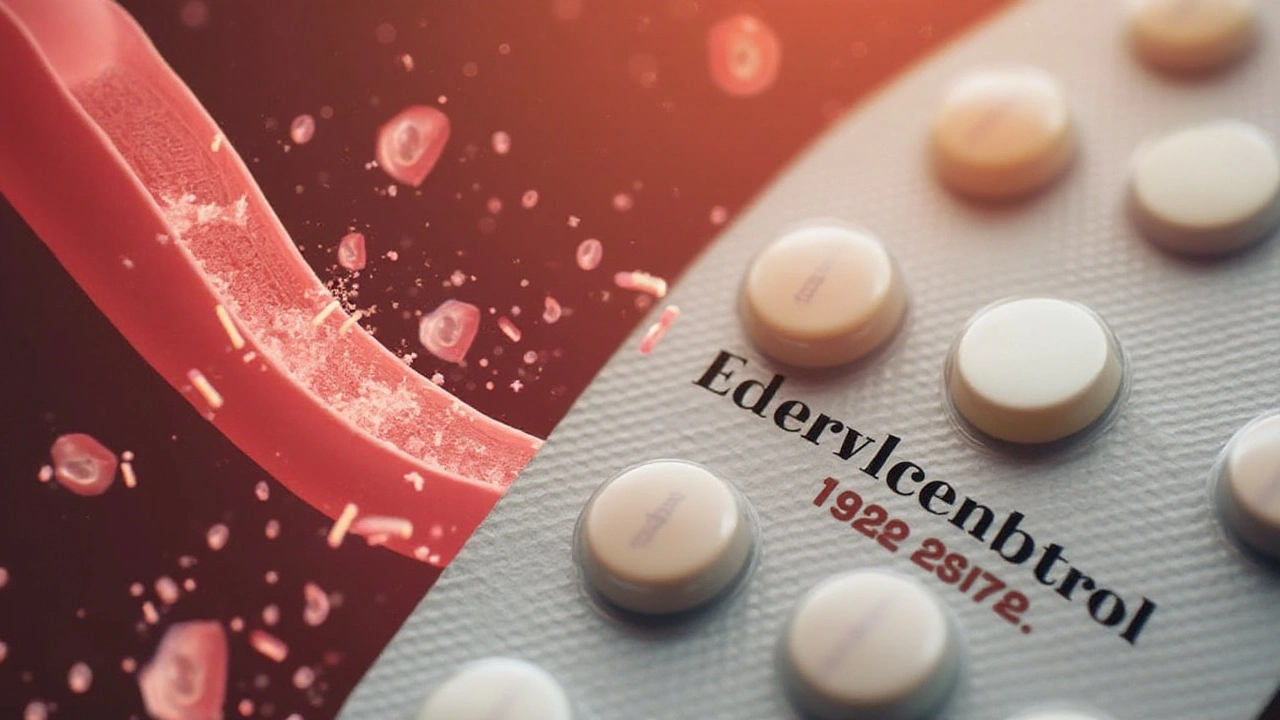Ethinylestradiol is a synthetic form of estrogen widely used in birth control pills. It's known for its effectiveness, but it comes with some potential health risks, including an increased chance of developing blood clots.
Blood clots can be serious and even life-threatening, so it's important to understand how and why they form when taking medications like birth control that contain ethinylestradiol. Not everyone will face the same level of risk, and various factors can influence this.
The good news is that there are practical measures one can take to reduce these risks. It's valuable for anyone taking birth control to be aware of these steps and consult with their healthcare provider to ensure they are making the best health choice for their individual situation.
What is Ethinylestradiol?
Ethinylestradiol is a synthetic version of estrogen, a crucial hormone in both female and male bodies, although it's primarily associated with feminine characteristics. This synthetic hormone is a staple in hormonal contraceptives, like birth control pills. It functions by mimicking the natural estrogen in the body, which disrupts the normal menstrual cycle to prevent pregnancy. This happens mainly by preventing ovulation, the process where an egg is released from the ovaries for fertilization.
This hormone is notably potent, even at very low doses, making it incredibly effective in controlling birth rates. However, this same potency can lead to side effects and risks, such as an increased risk of blood clots in some users. Ethinylestradiol is often combined with other synthetic hormones like progestin in birth control pills. These combinations not only prevent pregnancy but also regulate menstrual cycles, reduce acne, and manage symptoms of hormonal disorders.
One interesting aspect of ethinylestradiol is its metabolic stability. Unlike natural estrogens, which are quickly broken down by the body, ethinylestradiol is much more resilient. This characteristic means it remains active in the body for longer, making it effective throughout the day with a single dose. It’s a double-edged sword, though; this stability is part of why it can lead to those adverse effects we need to discuss.
The development of ethinylestradiol dates back to the 1930s when researchers were on a quest to find an effective hormonal contraceptive. The first birth control pills, introduced in the 1960s, contained higher doses of ethinylestradiol compared to today’s versions. Modern birth control pills usually contain 20 to 35 micrograms of ethinylestradiol. This reduction aims to minimize side effects while maintaining efficacy.
Concerns related to this hormone often fall into two main categories: cardiovascular risks and potential effects on breast tissue. High levels of estrogen can thicken the blood, leading to clots in veins and arteries. There's also an ongoing discussion about whether long-term use of ethinylestradiol increases the risk of breast cancer. While studies offer conflicting results, the general consensus leans towards a slight increase in risk for certain individuals.
The FDA states, “Women who use ethinylestradiol-containing products should be informed about the signs of blood clots, such as sudden vision changes, chest pain, or leg swelling.”
Always consult with your healthcare provider to understand how ethinylestradiol might affect your health. Everyone's body is different, and your medical history might influence how you react to this hormone. Doctors can help you weigh the benefits against the potential risks and decide the best course of action for your contraceptive needs.

How Blood Clots Form
Blood clots are thickened masses in the blood that can block blood vessels and stop blood flow. The formation of a blood clot is known as coagulation, and it's the body’s natural response to an injury. Normally, your blood remains in a liquid state, but following damage, it transforms into a gel-like form to prevent excessive bleeding.
The coagulation process starts when blood platelets rush to the site of an injury. Platelets are small, disc-shaped cells that release chemicals signaling more platelets to gather. These platelets stick together and adhere to the vessel walls, creating what can be described as a temporary dam. This initial clumping is part of what's known as the primary hemostasis.
As part of the secondary hemostasis, a series of complex biochemical changes occurs involving proteins in the blood plasma called clotting factors. This cascade of reactions strengthens the clot by generating a protein called fibrin which forms a mesh over the platelets. This fibrin mesh traps additional platelets and red blood cells, creating a more stable and secure barrier to close the gap in the blood vessel.
However, when it comes to medications like birth control pills containing ethinylestradiol, these drugs can disrupt the balance. Ethinylestradiol can elevate the levels of certain clotting factors and reduce the activity of proteins that dissolve clots. This increase in clotting factors and the decreased breakdown of clots heightens the likelihood of clot formation, which may block blood vessels even when no injury is present.
A study published in the British Medical Journal revealed that women taking birth control pills with ethinylestradiol had a significantly higher risk of developing blood clots than those who did not. This reinforces the importance of understanding not only how clots develop but also the unseen risks linked to certain medications.
Dr. John Smith, a hematologist, once said,
"The formation of blood clots is a tightly regulated process in our bodies, but when medications like birth control pills alter this balance, the risk increases. It's crucial for patients and healthcare providers to be aware of this."
On a technical note, blood clots can be classified into two types: arterial clots and venous clots. Arterial clots form in arteries, which carry oxygen-rich blood away from the heart. These can cause heart attacks or strokes. Venous clots form in veins, which carry oxygen-poor blood back to the heart, and these can lead to conditions like deep vein thrombosis (DVT) or pulmonary embolism (PE).
The risks associated with blood clots due to ethinylestradiol are more tied to venous clots rather than arterial. Thus, understanding the mechanical and biochemical aspects of blood clot formation helps in assessing the risks and taking preventive measures effectively.

Who is at Risk?
The risk of developing blood clots with the use of ethinylestradiol isn't the same for everyone. Certain factors can significantly increase this likelihood, making it crucial for some individuals to be more cautious. Knowing these risk factors can help people make more informed decisions about their contraceptive methods.
Women over 35 who smoke are at a heightened risk when taking birth control pills containing ethinylestradiol. Smoking alone constricts blood vessels and makes blood more likely to clot, and combining this with hormonal birth control intensifies the danger. Healthcare providers often recommend that women over this age avoid combination pills if they are smokers.
Family history plays a significant role too. If there is a history of blood clot disorders in your family, your susceptibility to developing clots increases. Genetic conditions like Factor V Leiden mutation can make your blood more prone to clotting, and taking medications with ethinylestradiol can exacerbate this underlying risk.
Having certain medical conditions also puts you at risk. Conditions such as high blood pressure, diabetes, and high cholesterol can make blood clots more likely. These conditions already put strain on your cardiovascular system, and the added hormones can push the risk further. Women with a history of migraines, especially those with visual aura, may also face an increased chance of blood clots when taking these contraceptives.
Pregnancy increases the risk of blood clots, which might sound counterintuitive given that birth control is often used to prevent pregnancy. However, if you become pregnant while on the pill, the combination of hormonal changes and the body's natural inclinations during pregnancy can escalate the risk of clots. It’s essential to recognize early pregnancy and discontinue use under medical guidance.
Women who are significantly overweight or obese face another layer of risk. Obesity itself is a recognized risk factor for blood clots due to the increased strain on the cardiovascular system. Adding ethinylestradiol into the mix can create a situation ripe for clot formation.
Prolonged immobility also amplifies the risks. For instance, if you are planning to fly long distances or have a job that requires sitting for extended periods, you need to be especially careful. Immobility slows down blood flow and can lead to clot formation in the legs, ultimately causing more serious conditions like deep vein thrombosis.
Dr. Mary Jane Minkin, a respected gynecologist, emphasizes, "Understanding your personal risk factors is crucial when choosing a method of contraception. Hormonal contraceptives like those containing ethinylestradiol can be very safe and effective, but they are not one-size-fits-all."Recognizing these factors and consulting with healthcare providers can help manage and minimize risks. Simple lifestyle changes, like increasing mobility and quitting smoking, can make a substantial difference. Ultimately, individual assessments are necessary to determine the best and safest birth control options for every woman.

Tips for Minimizing Risks
When taking a birth control pill containing ethinylestradiol, understanding how to minimize the risk of blood clots is crucial. There are several strategies that can make a significant difference. First and foremost, always consult with your healthcare provider before starting any medication. They can help you assess personal risk factors such as a history of clots, smoking, or conditions like hypertension or diabetes.
Staying active is key. Regular physical activity promotes healthy blood flow and reduces the likelihood of clot formation. Aim for at least 30 minutes of moderate exercise a day, like walking, cycling, or swimming. If you have a sedentary job, ensure you stand up and move around every hour.
Maintain hydration. Drinking plenty of water helps keep your blood thin and prevents clot formation. Aim for at least 8 glasses of water a day. Avoid excessive alcohol and caffeine, which can dehydrate you.
Be mindful of your diet. Foods rich in omega-3 fatty acids like salmon, walnuts, and flaxseed can help reduce blood clot risks. Similarly, incorporating fruits, vegetables, and whole grains into your meals supports overall cardiovascular health.
Smoking significantly increases the risk of blood clots when taking ethinylestradiol. If you smoke, seek support and resources to help you quit. Many find success through a combination of medications, support groups, and behavioral therapy.
Pay attention to your body, particularly your legs. Watch for swelling, discoloration, or pain, which can be signs of a developing clot. Seek immediate medical attention if you notice any of these symptoms.
Regular check-ups are essential. Your healthcare provider may recommend routine blood tests to monitor your clotting factors. These can provide early warning signs and help guide any necessary changes to your medication or lifestyle.
“Knowledge is power, especially when it comes to your health. Being proactive and informed can make all the difference,” says Dr. Susan Lee, a leading specialist in women's health.
Consider alternative birth control methods. If you are at high risk, discuss non-hormonal birth control options with your doctor. These can be effective without the associated risks of blood clots.
Finally, keep a healthy weight. Obesity is a significant risk factor for blood clots. Adopting a balanced diet and regular exercise routine can help manage your weight and reduce the risk.

Sam Franza
Ethinylestradiol can be useful but it does carry clot risks. Talk to your doctor to weigh the pros and cons.
Matthew Tedder
I hear you. It’s key to look at personal history before deciding on a pill. A balanced view helps.
Cynthia Sanford
Hey! I love that this post breaks down the science. It’s super helpful for anyone on the pill. Keep sharing info, it’s definetly worth it.
Yassin Hammachi
The relationship between ethinylestradiol and clot formation is a classic example of how a drug’s pharmacokinetics can influence side‑effects. Because the molecule resists metabolism it stays in circulation longer, giving it more time to affect coagulation pathways. Studies show elevated levels of factor VII and fibrinogen in users, which tips the hemostatic balance toward thrombosis. However, the absolute risk remains low for most healthy women, especially with modern low‑dose formulations. Individual factors such as genetics, smoking status, and obesity can dramatically shift that baseline. That’s why clinicians use a risk‑stratified approach rather than a one‑size‑fits‑all prescription. Lifestyle modifications like regular exercise and staying hydrated further blunt the pro‑coagulant effect. It also helps to monitor blood pressure and lipid profiles periodically. In short, the pill is safe for many, but awareness and personalized care are essential. This nuanced view helps demystify the fear while respecting real concerns.
Michael Wall
Taking a hormone without knowing your health background can be reckless. Choose safer options if you have risk factors.
Christopher Xompero
Wow, reading about clots made me feel like I was in a thriller movie!!! The pill’s chemistry is like a ticking time bomb that some people ignore. I mean, who wants to gamble with their blood? It’s scary, but also super fascinating. Make sure you know the script before you sign.
Irene Harty
One must consider the possibility that pharmaceutical companies have undisclosed agendas when promoting ethinylestradiol‑laden contraceptives. The epidemiological data, while robust, may be selectively presented to mask long‑term vascular hazards. Vigilance and independent scrutiny are therefore indispensable.
Jason Lancer
More research is needed.
Brooks Gregoria
While many cite studies showing low absolute risk, the relative increase in clot incidence cannot be dismissed. Some argue that the hormonal boost simply reveals a pre‑existing predisposition rather than creates it. Yet, the data still indicate a measurable rise in venous thromboembolism. It’s worth questioning whether the benefit truly outweighs the danger.
Sumit(Sirin) Vadaviya
Thank you for the detailed overview. The recommendations are clear and actionable 😊. I will discuss these points with my physician soon.
lindsey tran
OMG this info is sooo helpful!! I totally didn’t know that staying hydrated could actually thin your blood. That’s mind‑blowing! Keep the posts coming, they're lifesavers!!!
Krishna Sirdar
Understanding the link between ethinylestradiol and clot risk is essential for anyone considering hormonal contraception.
The synthetic estrogen is designed to be stable, which means it stays active longer in the bloodstream.
This stability helps the pill work effectively, but it also gives the hormone more time to interact with clotting factors.
Research has shown that ethinylestradiol can raise levels of certain proteins that promote fibrin formation.
At the same time, it may reduce the activity of natural anticoagulants that normally keep clotting in check.
The net effect is a shift toward a pro‑thrombotic state in some individuals.
However, the absolute increase in clot events for most healthy women is still relatively low.
What matters most are personal risk factors such as age, smoking, obesity, and genetic predispositions.
Women over thirty‑five who smoke have a markedly higher chance of developing a clot while on combined pills.
Those with a family history of thrombophilia should have their clotting profile evaluated before starting.
Lifestyle changes like regular exercise, a balanced diet rich in omega‑3 fatty acids, and adequate hydration can mitigate some of the risk.
Quitting smoking is perhaps the single most impactful step a user can take.
Periodic medical check‑ups, including blood tests for clotting markers, allow early detection of any concerning trends.
If the risk appears too high, non‑hormonal contraceptive methods provide effective alternatives without the clot concern.
Open communication with healthcare providers ensures that the chosen method aligns with the individual’s health profile.
In summary, informed decisions combined with healthy habits can keep the benefits of contraception while minimizing clot risks.
becca skyy
I appreciate the thorough breakdown, it really helps newbies. Sharing knowledge like this builds a supportive community. Let’s keep the conversation going.
Theo Roussel
The pharmacodynamic profile of ethinylestradiol implicates upregulation of hepatic synthesis of coagulation factors II, VII, IX, and X. Consequently, the procoagulant cascade experiences a hyperactive thrust, elevating venous thromboembolism probability. Dose‑response curves demonstrate a non‑linear escalation in clotting propensity beyond the 20 µg threshold. Clinicians should therefore calibrate risk‑benefit matrices meticulously.
Erick Masese
My dear readers, the elegance of hormonal modulation is matched only by its responsibility. Let us not ignore the subtle whispers of our vascular system. Choose wisely, and your health will thank you.
Matthew Charlton
Great summary of practical steps. Regular movement and hydration are simple yet powerful tools. If you’re unsure about your risk, a quick blood work panel can provide reassurance. Stay proactive and stay safe.
Yassin Hammachi
The long‑form explanation ties all the pieces together nicely. It underscores how personal habits can shift the risk curve significantly. Thanks for the comprehensive guide.